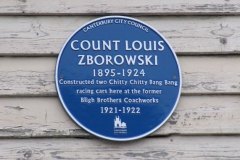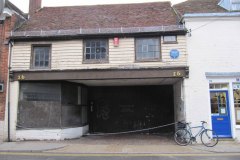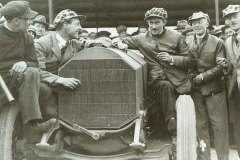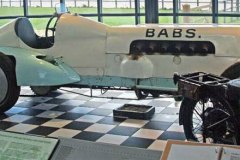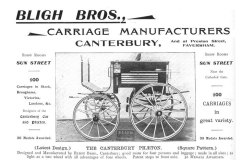Racing Car Builder & Driver
Count Louis Zborowski was born in 1895 in Mayfair, son of a Polish count and racing driver married to an American heiress. His father died in a motor racing accident in France in 1903, and in 1910 his mother purchased the Grade II listed Higham Park near Bridge. She was to live only 3 months longer, leaving the 16 year old Louis alone in the world apart from his £16 million inheritance and 7 acres of Manhattan. By the early 1920s he was building aero-engined cars and racing them with some success. Several of his successful cars acquired the nickname ‘Chitty bang bang’, derived from WWI soldiers’ songs where chitty was the permission to leave camp and bang bang whatever the soldier did with his time off – art galleries, country walks etc (?!). The writer-to-be Ian Fleming as a 12 year old boy saw Zborowski race at Brooklands, and decades later used the name (with an extra chitty added) as the title for a children’s story, popularised in the film that followed in 1968. The Count died in 1924 when his car hit a tree in the Italian Grand Prix at Monza – he was aged only 28. Fleming apparently visited Higham House in the years following the Count’s death, travelling to Dover on the 007 bus. The number had a ring he thought he might use in later novels.
The Canterbury link with the Zborowski story is rather tenuous. He used the local firm Bligh Brothers in St Radigund Street for engineering and body building work on his cars. William Bligh had a wheelwright business in Duck Lane in the mid 19th century, and with his sons William and John, and later with brothers Jasper and Henry, expanded the firm during the 1860s and 1870s into coach building, and into the adjacent Radigund Street premises. The firm also opened a showroom in Sun Street. The arrival of Chitty Bang Bang in the 1920s was not welcome to locals – the noise of the aero-engines was unbearable and the cars were banned from entering the city walls. The Bligh’s Radigund Street property is now owned by King’s School.
One of Zborowski’s cars, known as Chitty 4 or Babs, has survived in the Pendine Museum of Speed in South Wales. The car was acquired after Zborowski’s death by the Welsh driver Parry Thomas, who died in 1927 on Pendine sands trying to beat Malcolm Campbell’s land speed record of 146 mls/hour. The car lay buried in the sand until 1969 when it was excavated and restored.
Sources: Evans (1903) including Image 5 above; Harding (2009) including Image 3 above; Times 18 July 2008; Kentish Gazette 9 Dec 2010; web site Grace’s Guide; web site for Pendine Museum of Speed
DL

